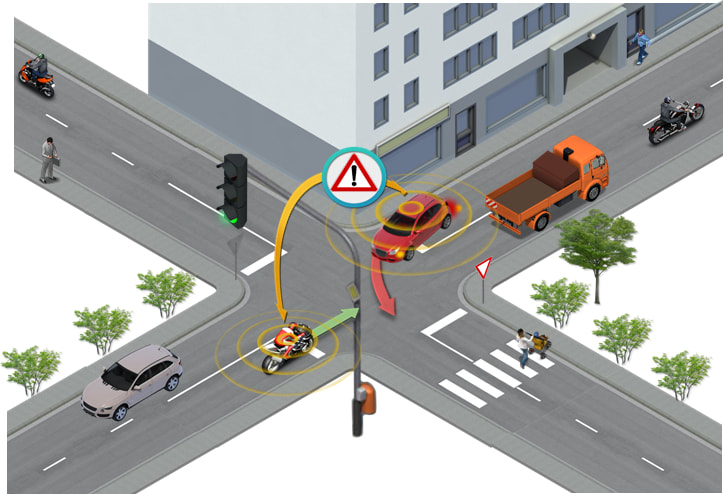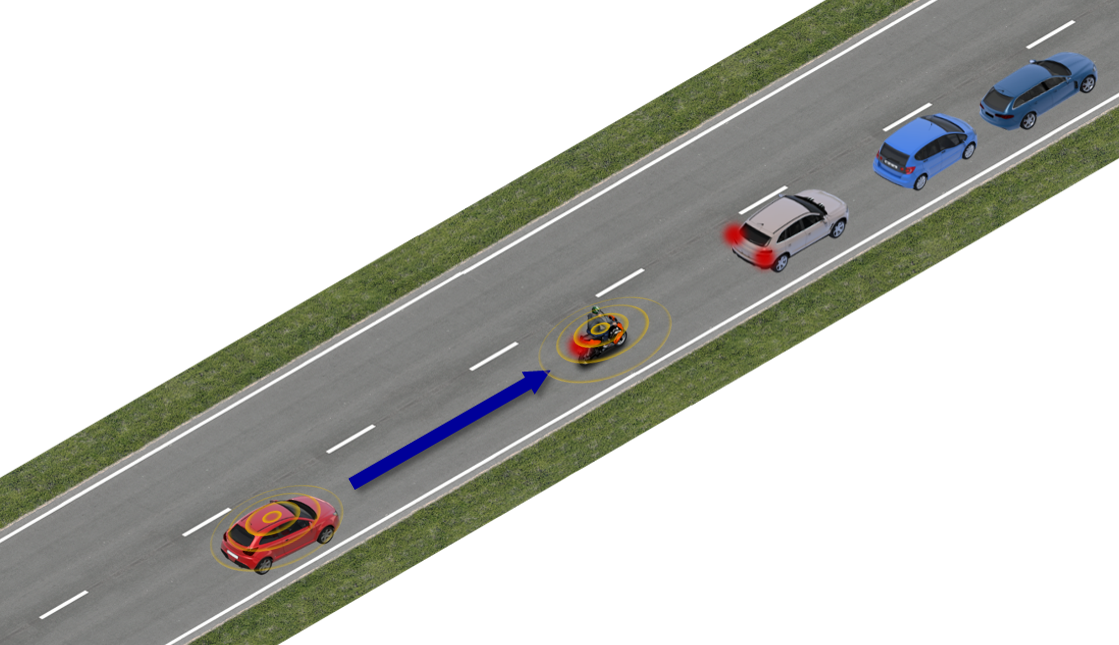Examples of various scenarios
Connectivity between vehicles enables the possibility to warn drivers in case of many scenarios where there may be imminent danger. Many of such warnings are under development by the car industry. However, for motorcycle specific situations, they should be particularly adapted for motorcycles, or even newly developed.
Currently the Connected Motorcycle Consortium is working on around 30 of these so-called 'use cases'; several examples are illustrated below.
Some are specifically aimed at the motorcycle rider him/herself, for example to warn about unexpected occurences; some are aimed at the drivers of other vehicles, to make them aware that a motorcycle is nearby.
Currently the Connected Motorcycle Consortium is working on around 30 of these so-called 'use cases'; several examples are illustrated below.
Some are specifically aimed at the motorcycle rider him/herself, for example to warn about unexpected occurences; some are aimed at the drivers of other vehicles, to make them aware that a motorcycle is nearby.
® Visuals were created using the C2C-CC Illustration Toolkit, owned by the CAR 2 CAR Communication Consortium
We start with a group of cases where motorcycles should be seen, so where warnings are sent to the other vehicle drivers
Motorcycle Approach Indication
MAI is an application that informs a vehicle driver that an approaching motorcycle is nearby, even if the driver cannot see the motorcycle.
If, based on movement data, a possible crossing with the motorcycle is detected, or the relative distance between the two vehicles decreases below a given margin, an advisory warning is issued to the vehicle driver. (In case of heavy traffic with many motorcycles nearby, it may be that this indication shall be paused in order not to overload the driver.) |
Motorcycle Approach WarningMAW is a generic term for a group of applications like IMA, LTA, FCW, DNPW and BSW which warn a vehicle driver who has an imminent risk to collide into a motorcycle. This goes beyond the general notice that a motorcycle is approaching, like MAI provides. The MAW system is more sophisticated because if the precision of movement information of vehicles is accurate enough, it calculates the risk of collisions and only provides warnings to the vehicle driver if a collision is likely.
(There is also the possibility for the system to send a warning to the motorcycle, alerting the rider of the forthcoming danger.) |
Intersection Movement Assist
The IMA application warns the driver of a vehicle when it is not safe to enter an intersection or a roundabout due to high probability of collision with other vehicles. The ‘Time-To-Collision’ is calculated and a warning is only issued when a collision is likely to occur.
IMA will operate on intersections, including parking lot entrances, roundabouts and other kinds of junctions where vehicles might cross encounter zones. |
Left Turn Assist
The LTA system determines the intention of a left turn, and checks if vehicle drivers actually overlook an oncoming motorcycle, or incorrectly estimate its speed. It calculates the risk of an accident and displays a warning to the driver if necessary. The system continues to work at traffic lights, regardless of which lights are shown.
LTA is not designed to be active in case of parking space areas and traffic jams. The name 'Left Turn Assist' is based on right hand side driving; obviously in case of left hand side driving it will act as a 'Right Turn Assist'.
|
Forward Collision Warning
The FCW application is intended to warn the car driver or motorcycle rider in case of an impending front collision caused by suddenly appearing obstacles, very slow vehicles ahead, crossing or wrong way driving vehicles. The system shall detect situations where the vehicle may run into a forward collision if the rider does not immediately reduce speed or initiate emergency braking.
|
Do No Pass Warning
The DNPW application warns a vehicle driver who attempts to pass, that passing is not safe due to vehicles coming from the opposite direction. Especially for oncoming motorcycles this is beneficial because their speed or distance is sometimes likely to be misjudged by car drivers. In case a passing maneuver is not being attempted yet, the system may still provide an advisory warning that the passing zone is occupied.
|
Next up is a wide range of other cases where warnings could be sent to the motorcycle rider him/her self.
Emergency Electronic Brake Light
The EEBL application enables a vehicle to broadcast its own emergency braking situation to surrounding vehicles, including those that have their line of sight obstructed by other vehicles or bad weather like fog or rain.
In case there are multiple vehicles driving behind each other, and the first vehicle has to perform an emergency braking, this application drastically reduces the delay in reaction time by subsequent vehicles: each driver/ rider is informed immediately and the risk of collision could be avoided. |
Traffic Jam Warning
The TJW application warns riders of a traffic jam ahead. By doing this well in advance, the rider can reduce speed or even choose to change their route and avoid the traffic jam, when possible. This way the system can contribute in avoiding possible rear-end collisions, although it is not an immediate emergency crash avoidance system like the 'Forward Collision Warning' (which engages when an actual crash is imminent).
|
In-Vehicle Signage
The IVS application shows important road signs on the vehicle's information display. This way it emphasizes the road sign once more. This could include static signs like stop signs or curve warnings, as well as dynamic signs like railroad crossings. On top of that: it could also receive sign information from maintenance and construction and emergency vehicles in the vicinity, e.g. in work zones and around incidents, where there is no fixed infrastructure.
|
Green Light Optimal Speed AdvisoryBy sharing information with traffic light infrastructure, the GLOSA system can provide a speed advisory to the rider, so that the motorcycle can pass the oncoming intersection while the traffic light is green.
This will enable a smoother traffic flow and optimum efficiency by avoiding unnecessary braking and acceleration. The application can also display the remaining time till green in case the light is red, and so mitigates rider’s stress. |
Slow or stationary Vehicle WarningThis SVW system helps to prevent rear-end collision accidents by warning the motorcycle rider approaching to a slow or stationary vehicle ahead. The slow state of the vehicle is defined by vehicle information such as speed, gear position, having hazard lights on, etc.
When the motorcycle itself is in a slow or stationary state, this system can inform following vehicles so as to prevent the motorcycle rider from being overlooked and hit by a following vehicle.
|
Broken Down Vehicle WarningThe BDVW application warns the motorcycle rider approaching to a vehicle with a defect. Due to a crash or a breakdown, the vehicle might be blocking a lane, hence providing an increased accident risk. When the motorcycle itself is broken down, this system can inform vehicles in the vicinity and prevent the motorcycle from being overlooked and hit.
Note: if vehicles are stationary for other reasons, this will be covered by the 'SVW' application. |
Lane Change / Blind Spot Warning
The LCW / BSW application is intended to warn the rider of a motorcycle during a lane change attempt if the blind-spot zone into which the bike intends to switch is, or will soon be, occupied by another vehicle traveling in the same direction. Moreover, the application provides information that is intended to inform the rider that another vehicle in an adjacent lane is positioned in a blind-spot zone of the vehicle even if a lane change is not being attempted.
|
Road Works WarningRoadworks are typically prone to accidents, because they are realized too late by the oncoming traffic. The RWW application provides information about the presence of a work zone, to the vehicles approaching it. This way the rider can be warned about the exact danger spot and informed about location and length of the roadworks.
|

















